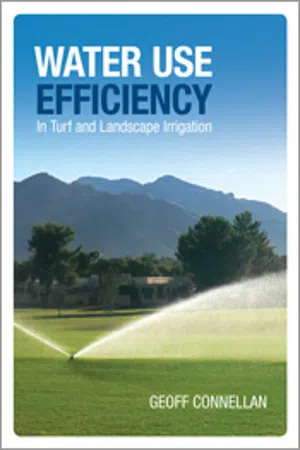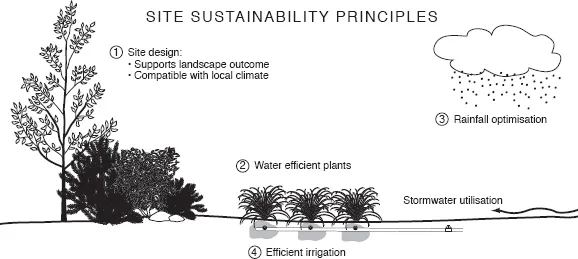
- 432 pages
- English
- ePUB (mobile friendly)
- Available on iOS & Android
Water Use Efficiency for Irrigated Turf and Landscape
About This Book
Achieving high water use efficiency in maintaining turf, trees and landscape areas is a core responsibility of open space managers. Water Use Efficiency for Irrigated Turf and Landscape provides a logical and scientifically sound approach to irrigation in urban areas in Australia. It is based on green space delivering defined outcomes using the principles of water sensitive urban design and irrigation efficiency.
The book covers all stages of the water pathway – from the source to delivery into the plant root zone. Major topics include system planning, estimating water demand, water quality, irrigation systems, soil management and irrigation performance evaluation.
Clearly presented explanations are included, as well as line drawings and worked examples, and a plant water use database covering more than 250 plant species. A Water Management Planning template is included to guide water managers and operators through a process that will deliver a sound plan to achieve sustainable turf, urban trees and landscapes.
Best Management Practice Irrigation principles are outlined and their implementation in open space turf and landscape situations is explained. The benefits and limitations of the various methods of delivering water to plants are covered, together with case studies and guidelines for specific horticultural situations. Methodologies to evaluate irrigated sites are included along with recommended benchmark values.
The book presents the latest irrigation technology, including developments in water application, control technology and environmental sensors such as weather stations, soil moisture sensors and rain sensors.
Frequently asked questions
Information

- The extraction of water for irrigation does not have a negative impact on the water source and the environment.
- Water security is achieved.
- The irrigated area (landscape) is suited to its intended purpose.
- The inputs (water, chemicals, energy and labour) used are minimised, used efficiently and managed so that environmental health is protected and the maintenance demands are minimised.
- The capacity of the organisation is appropriate to manage the landscape, both in terms of resources used and outcomes or services, to be provided.
- The business and functions of the site are viable.
- The site is designed, including selection of plants, to minimise the demand for supplementary irrigation water.
- The hydrology of the site is assessed and managed to optimise the use of rainfall.
- The amount of supplementary water provided is matched to the site vegetation, soils and weather.
- Irrigation is carried out efficiently.
- An annual irrigation water requirement and water budgets are prepared for the site and used for ongoing monitoring and evaluation.
- A secure non-potable water supply is a planning objective.
- Resource management practices associated with the irrigated site, such as fertiliser and chemical, have no negative impact on the environment (thus protecting soil health and water bodies).
- Water management is carried out to best management practices standards, within a framework, that encourages continual improvement.
Table of contents
- Cover
- Title
- Copyright
- Contents
- Acknowledgement
- Preface
- Chapter 1 Sustainable water use and efficiency
- Chapter 2 The urban water scene
- Chapter 3 Water sources for irrigated turf and landscape sites
- Chapter 4 Irrigation methods
- Chapter 5 Plant water use and irrigation budgets
- Chapter 6 Managing soil water and irrigation scheduling
- Chapter 7 Best management practice (water management and irrigation)
- Chapter 8 Designing irrigation systems
- Chapter 9 Achieving best practice - site studies
- Chapter 10 Strategies and technologies to achieve high efficiency
- Chapter 11 Evaluating and benchmarking irrigation system performance
- Chapter 12 Water management planning
- Appendix 1 Acronyms, terms and units
- Appendix 2 Glossary of terms
- Appendix 3 Climate data
- Appendix 4 Plant water use
- Appendix 5 Salt tolerance
- Appendix 6 Turfgrass characteristics used in species selection
- Appendix 7 Water quality analysis and report (example)
- Appendix 8 Pipe friction
- Appendix 9 Pump performance curve - fixed speed, variable impeller diameter
- Appendix 10 Australian standards relevant to irrigation and water supply
- Appendix 11 Metrics and conversions
- References
- Index